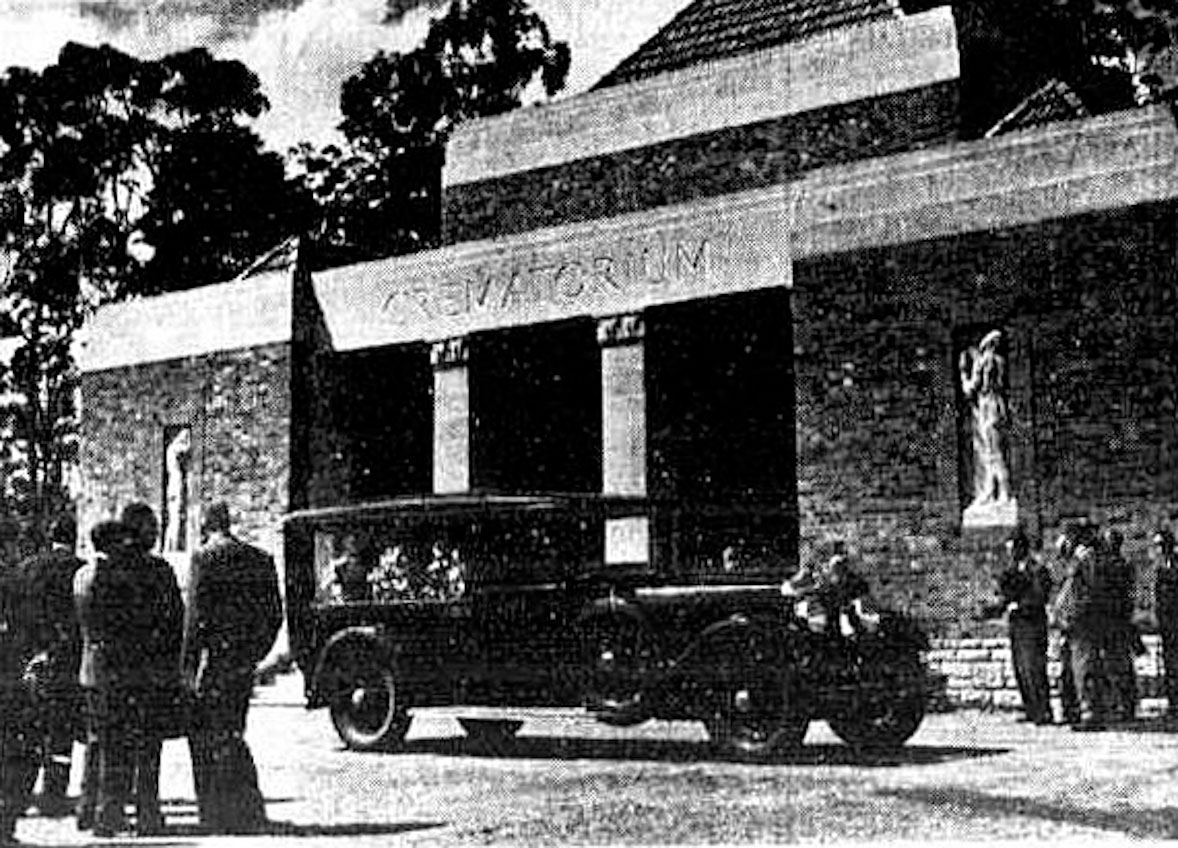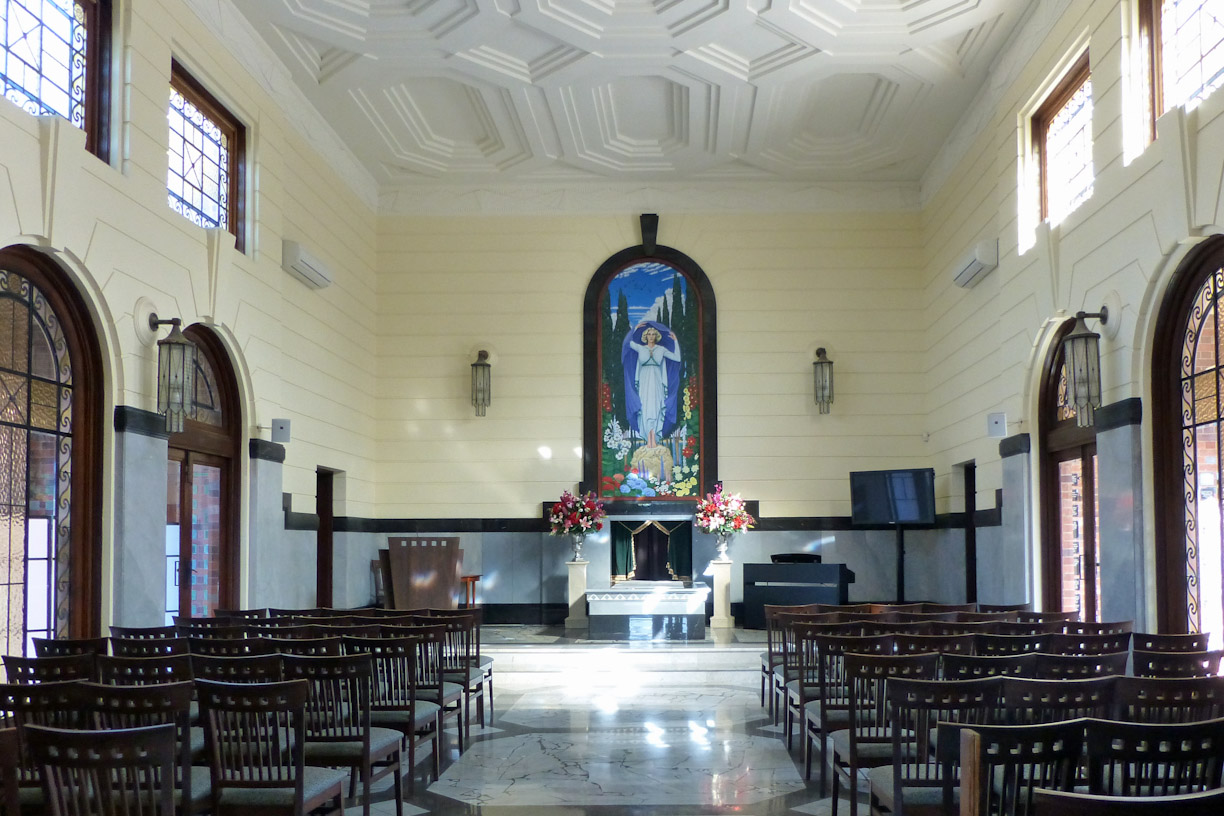Mount Thompson Crematorium on:
[Wikipedia]
[Google]
[Amazon]
Mount Thompson Memorial Gardens and Crematorium (formerly Brisbane Crematorium) includes a heritage-listed chapel (the West Chapel), columbaria and other features. It is located on north-western slopes of Mount Thompson in
 Mount Thompson Crematorium officially opened on Sunday 9 September 1934. The first cremation service was held on the morning of 11 September 1934. A religious service for Neil Richmond Rose of Wynnum, Queensland was held at 10.30am followed by a non-religious one for Ernest Charles Fletcher of Ularunda Station, central Queensland at 2.30pm.
During the Second World War, there were 88 Australian service personnel cremated here whose remains rest at the crematorium and are commemorated by
Mount Thompson Crematorium officially opened on Sunday 9 September 1934. The first cremation service was held on the morning of 11 September 1934. A religious service for Neil Richmond Rose of Wynnum, Queensland was held at 10.30am followed by a non-religious one for Ernest Charles Fletcher of Ularunda Station, central Queensland at 2.30pm.
During the Second World War, there were 88 Australian service personnel cremated here whose remains rest at the crematorium and are commemorated by  The West Chapel underwent five months restoration commencing in 2007 and reopening in February 2008. The chapel was returned to its original configuration with removal of pews and installation of single chairs as well as restoration of terrazzo flooring, lead lighting and the catafalque and its surrounds. A reproduction by Scott Christensen of
The West Chapel underwent five months restoration commencing in 2007 and reopening in February 2008. The chapel was returned to its original configuration with removal of pews and installation of single chairs as well as restoration of terrazzo flooring, lead lighting and the catafalque and its surrounds. A reproduction by Scott Christensen of
Brisbane
Brisbane ( ) is the capital and most populous city of the states and territories of Australia, Australian state of Queensland, and the list of cities in Australia by population, third-most populous city in Australia and Oceania, with a populati ...
, Australia. The street address is Nursery Road in Holland Park. It was established in 1934 as the first crematorium
A crematorium or crematory is a venue for the cremation of the dead. Modern crematoria contain at least one cremator (also known as a crematory, retort or cremation chamber), a purpose-built furnace. In some countries a crematorium can also b ...
in Queensland.
History
The crematorium was the first in Queensland and was constructed after many decades of lobbying and public discussion, culminating in a group of citizens meeting and forming the Brisbane Crematorium Limited in 1930. Shares were sold in the company and a suitable site was purchased in 1933. Early designs were done byRichard Gailey, Junior
Richard is a male given name. It originates, via Old French, from Old Frankish and is a compound of the words descending from Proto-Germanic ''*rīk-'' 'ruler, leader, king' and ''*hardu-'' 'strong, brave, hardy', and it therefore means 'stron ...
(the son and business partner of Richard Gailey
Richard Gailey, Sr. (22 April 1834 – 24 April 1924) was an Irish-born Australian architect.
Gailey was born in Donegal, Ireland and emigrated to Australia in 1864, becoming an influential and prolific architect in colonial-era Brisbane. He ...
). However, Melbourne architects Charles and Frank Heath were appointed as the crematorium designers and worked in partnership with Brisbane architects GHM Addison and Son and HS Macdonald who prepared further plans and specifications.
Artist William Bustard
William Bustard (1894–1973) was an artist in Queensland, Australia. His stained glass work features in many heritage-listed buildings.
Early life
William Bustard was born in 1894 in Terrington, Malton, Yorkshire, England. Living close to the ...
was engaged to work on a canvas mural representing the awakening from death which was positioned over the catafalque in the chapel.
Sculptor Daphne Mayo
Daphne Mayo (1 October 1895 – 31 July 1982) was a significant 20th-century Australian artist, most prominently known for her work in sculpture, particularly the tympanum of Brisbane City Hall, and the Women's War Memorial in ANZAC Square.
...
was commissioned to create three relief works, ''Grief'' and ''Hope'' for the front facade and one of a boy scattering seed, representing the continuation of life, for the original columbarium.
 Mount Thompson Crematorium officially opened on Sunday 9 September 1934. The first cremation service was held on the morning of 11 September 1934. A religious service for Neil Richmond Rose of Wynnum, Queensland was held at 10.30am followed by a non-religious one for Ernest Charles Fletcher of Ularunda Station, central Queensland at 2.30pm.
During the Second World War, there were 88 Australian service personnel cremated here whose remains rest at the crematorium and are commemorated by
Mount Thompson Crematorium officially opened on Sunday 9 September 1934. The first cremation service was held on the morning of 11 September 1934. A religious service for Neil Richmond Rose of Wynnum, Queensland was held at 10.30am followed by a non-religious one for Ernest Charles Fletcher of Ularunda Station, central Queensland at 2.30pm.
During the Second World War, there were 88 Australian service personnel cremated here whose remains rest at the crematorium and are commemorated by Commonwealth War Graves Commission
The Commonwealth War Graves Commission (CWGC) is an intergovernmental organisation of six independent member states whose principal function is to mark, record and maintain the graves and places of commemoration of Commonwealth of Nations mil ...
(CWGC) memorial here. Another 36 Australian service personnel cremated here whose remains were scattered or buried at places where CWGC commemoration was not possible are commemorated on the CWGC's Queensland Cremation Memorial in Lutwyche Cemetery
Lutwyche Cemetery is a cemetery located at Kedron, Brisbane, Queensland, Australia. It opened in 1878 and saw its first burial in the same year. It is located at the corner of Gympie and Kitchener Roads, approximately ten kilometres north of B ...
. They included First World War fighter ace
A flying ace, fighter ace or air ace is a military aviator credited with shooting down five or more enemy aircraft during aerial combat. The exact number of aerial victories required to officially qualify as an ace is varied, but is usually co ...
Roy Phillipps
Roy Cecil Phillipps, MC & Bar, DFC (1 March 1892 – 21 May 1941) was an Australian fighter ace of World War I. He achieved fifteen victories in aerial combat, four of them in a single action on 12 June 1918. A grazier b ...
who was killed flying while serving in the Royal Australian Air Force
"Through Adversity to the Stars"
, colours =
, colours_label =
, march =
, mascot =
, anniversaries = RAAF Anniversary Commemoration ...
in 1941. In addition a Royal Australian Artillery
The Royal Regiment of Australian Artillery, normally referred to as the Royal Australian Artillery (RAA), is a Regiment of the Australian Army descended from the original colonial artillery units prior to Australia's federation. Australia's first ...
soldier cremated here is, exceptionally, commemorated on the Victoria Cremation Memorial in Melbourne.
Over the years further columbaria and gardens were constructed, adjacent land acquired and facilities expanded. By 1962 an additional chapel had been built, designed by Adrian Pooley. The new chapel was designated the East Chapel and the original, the West Chapel.
Renowned architect Karl Langer
Karl Langer, Ritter von Edenberg (15 April 1819, Vienna – 8 December 1887) was an Austrian anatomist. He is known for his work in the field of topographical anatomy.
He studied medicine at the Universities of University of Vienna, Vienna and C ...
received commissions in the 1960s to design a number of new columbaria and to modify the West Chapel including new pews, kneeling rails, a new marble lined pulpit and removal of Bustard's original mural with reworking of the walls and catafalque surrounds.
 The West Chapel underwent five months restoration commencing in 2007 and reopening in February 2008. The chapel was returned to its original configuration with removal of pews and installation of single chairs as well as restoration of terrazzo flooring, lead lighting and the catafalque and its surrounds. A reproduction by Scott Christensen of
The West Chapel underwent five months restoration commencing in 2007 and reopening in February 2008. The chapel was returned to its original configuration with removal of pews and installation of single chairs as well as restoration of terrazzo flooring, lead lighting and the catafalque and its surrounds. A reproduction by Scott Christensen of William Bustard
William Bustard (1894–1973) was an artist in Queensland, Australia. His stained glass work features in many heritage-listed buildings.
Early life
William Bustard was born in 1894 in Terrington, Malton, Yorkshire, England. Living close to the ...
's original mural painting was also commissioned and installed.
The East Chapel was also refurbished in the 2000s with modern lighting, podium work and contemporary seating installed.
Description
The original 1934 crematorium building is art deco in style. It is a brick structure with stone facings including a portico flanked with stone pillars. It included originally a chapel, mortuary, retort room, columbarium garden, pond and offices. Large arched openings overlook a columbarium garden and pond. The walls of the chapel are lined with a dado of Queensland marble in black and dove grey. The floor is terrazzo with marble borders.Heritage listing
The crematorium is listed on theBrisbane Heritage Register
The Brisbane Heritage Register is a heritage register containing a list of culturally-significant places within the City of Brisbane, Queensland, Australia
Australia, officially the Commonwealth of Australia, is a sovereign country comp ...
.
References
External links
* {{Cemeteries in Queensland, state= collapsed Crematoria in Queensland 1934 establishments in Australia Cemeteries in Brisbane Holland Park, Queensland